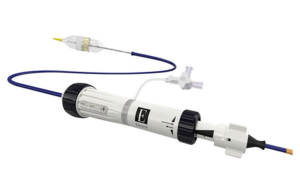
A catheter is a tube that can deliver devices or pharmaceuticals into the body. It is also commonly used for diagnostic purposes. A catheter has a hub or a handle on its end that can connect to a syringe or something that actuates a device.
There are a number of catheter delivery systems currently on the market that deploy devices such as heart pumps, balloons, stents and other clot-busting products.
The catheters need to be small enough to fit through the blood vessels and flexible enough to navigate the human body’s complex cardiovascular system.
Sean Chow, a senior director of R&D at Edwards Lifesciences, told Medical Design & Outsourcing about three pitfalls that creators of catheter-based delivery systems should avoid.
1. Tangible prototypes are better than a computer screen.
Computer programs can make every catheter design possibility seem easy — but the real innovation starts with building an actual model and testing prototypes.
Having a tangible prototype of a catheter delivery system allows an engineer to see the device’s shortcomings and feel what they can do, according to Chow. From there, an engineer can create new iterations of the device and improve.
“If you can detect 95% of the failures in a model, then you won’t have a failure in humans. As you continue to iterate, it sparks more and more ideas,” Chow said. “You go from 95% confidence to 97% confidence to 98% confidence, 99.9% confidence. You just become more and more confident the more you use models.”
You will eventually end up designing what your model has shown you.
2. Rigidity from guide catheters is essential for delivering devices through catheters
One can compare a catheter by itself to a rope, Chow said. Without any constrains, a rope won’t push toward the direction it needs to because it’s soft. The easiest way to push the rope is to create a tunnel. For catheter delivery systems, a guide catheter facilitates the movement of the soft catheters.
Guide catheters are stiff and provide support for devices like balloons or stents to move into the complex anatomy of the human vasculature system.
“A guiding catheter can really help you push something. It doesn’t flop around as much when you have a guiding catheter. It’s unable to bow when it’s constrained on the outside.”
3. Follow the wire
Catheters need to be soft to get to distant structures of the body, but the softness makes the catheter more difficult to control. As a result, almost everything done in catheter delivery systems is about following the wire because variable stiffness is a very important part of catheter design, Chow said.
“Imagine your catheter as a rope with a hole inside of it, like a coaxial hole that runs the whole way down. What you want to do is run that rope over a wire.”
The torquability and variable flexibility of a guidewire allows a physician to maneuver the catheter into tortuous anatomies and control the direction in which it goes. When you have a catheter following that wire, the closer to the hand the catheter is, the stiffer it needs to be. The distal end of the catheter needs to be soft and the proximal end needs to be stiff. It is also important that the transitions between the stiff and soft areas are gradual in nature.
“To follow the wire, design things that are soft on the part where it needs to go to be tracked,” Chow said. “As you go further and further back and closer to your hand, it needs to get stiffer and stiffer because you need something to push on.”

